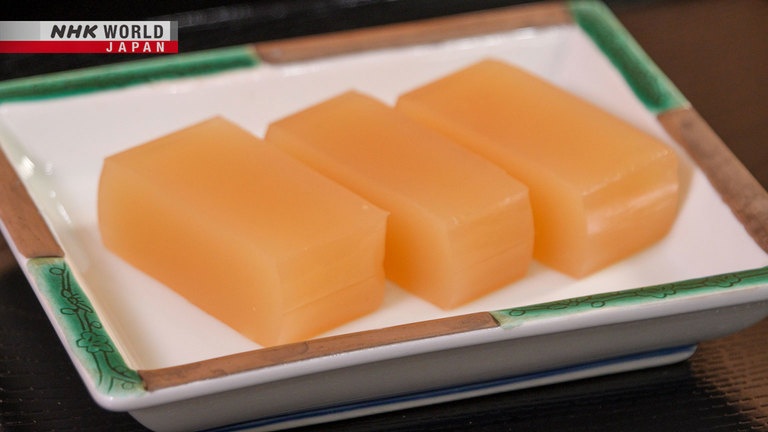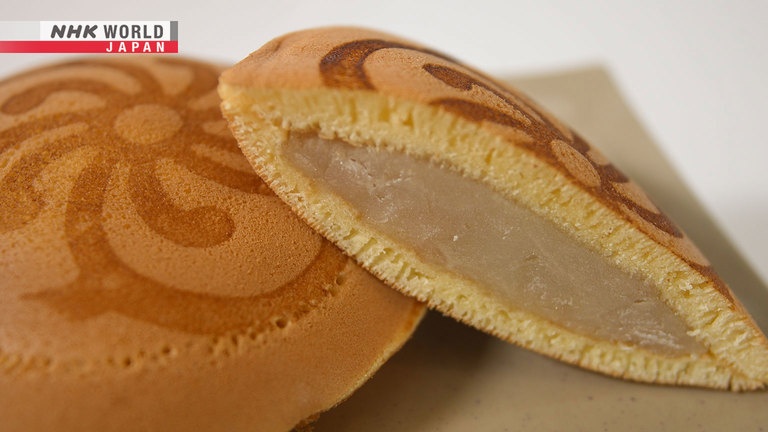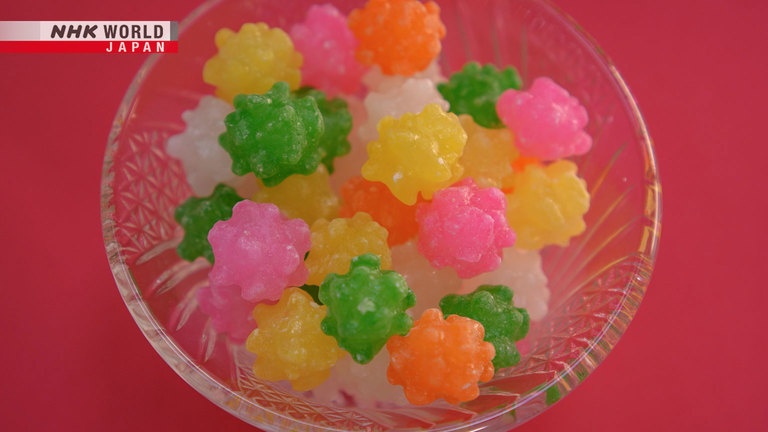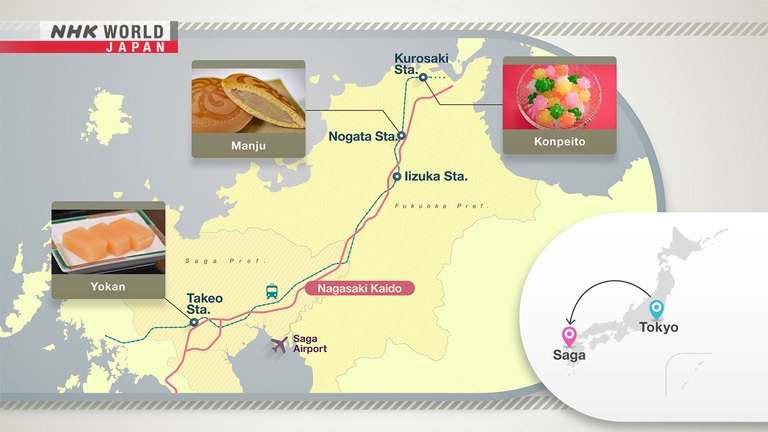On the Sugar Road from Saga to Fukuoka
The Nagasaki Kaido was an important trade road from the 1630s that connected Nagasaki's port—the only one open to overseas trade in those days—to Kokura in Fukuoka Prefecture. Nicknamed the Sugar Road, the 220-kilometer path carried covetous sugar and their sweet recipes. Aliza Ahmed Khan from Pakistan discovers the distinctive confectionery culture that developed along the route.
Yokan

This signature Saga Prefecture sweet is made with adzuki beans, sugar, starch syrup and agar.
Narikin Manju

Narikin means becoming rich overnight. The bun is named after the old coal barons in Nogata and other mining towns in central Fukuoka Prefecture.
Konpeito

This sphere-shaped sugar candy, which has its roots in Portugal, is known for its spiky protrusions.
Access

From Tokyo, it takes about 2 hours to Kyushu-Saga International Airport. To reach Takeo from Saga, take the JR Kyushu Sasebo Line. Iizuka, Nogata and Kurosaki can be accessed on the Chikuho Line.
Transcript
"Journeys in Japan"
It was in the 17th century
when a European trading vessel unloaded a treasure in Nagasaki
that would revolutionize food culture.
The commodity was sugar.
It looks so hot.
People in Kyushu soon developed a sweet tooth for the array of treats
created with the coveted ingredient.
Aliza Ahmed Khan is originally from Pakistan.
She follows the old road out of Nagasaki that conveyed sugar around Japan.
This is a place where the cobblestone street continues
and the old-time atmosphere is preserved.
Walking along this path makes me think about how many people
have gone through it from past till now.
Well, around the world,
there are so many famous roads like Silk Road, Salt Road,
paths for pilgrimages, but I think this Sugar Road
is something that you will only find in Japan.
Exploring the sweets developed in each place along the route
is a way to taste local culture
and get a delicious look into the past.
This is so big.
Bigger than me!
They get large.
I have a gift for you.
On "Journeys in Japan,"
we savor the confectionery traditions that blossomed along the Sugar Road.
On The Sugar Road from Saga to Fukuoka
The Nagasaki Kaido, or the Sugar Road,
courses through the prefectures of Nagasaki, Saga and Fukuoka.
Spanning over 200 kilometers, it was developed in the early 17th century.
The route linked Nagasaki's Dejima,
the only official point of trade with the West, to Kokura,
which was accessible to main island trade routes.
We hit the road in Takeo.
Hey there. In Japanese "ryokans," they have this adorable tradition.
You will get these tiny and cute snacks right in your room.
I love trying different ones every time I visit a new place.
Mmm, yummy.
This trip, I'm excited to try and explore lots of Japanese sweets.
This striking red and white color.
This is the iconic gate of Takeo Onsen.
And today I'm going to start my journey from here. Let's go!
Welcome.
Wow, it's a cute shop.
What's a famous Saga confectionery?
It's the "marubouro."
You can see it displayed here.
It's like a cookie.
Marubouro are inspired by Portuguese "bolo" or cakes.
The recipe calls for wheat flour, eggs, sugar and "mizuame" starch syrup.
"Yokan," made with "adzuki" bean paste, sugar and agar,
is also common along the Nagasaki Kaido.
Once reserved only for samurai and priests at tea ceremonies,
later it became available to ordinary people.
Soldiers carried them as an energy source.
Travelers took them home as souvenirs.
Excuse me.
- What's in there?
- "Itokanten" or agar, the base for yokan.
Itokanten?
- Is it sweet?
- It's not sweet.
We soften the itokanten by soaking it overnight in water.
The yokan won't solidify without it.
What is it?
Seaweed.
- What do you add next?
- Sugar.
Look at that.
Flour of white adzuki beans that are dried after boiling.
Next, the mizuame rice starch.
The syrup gives yokan its luster and moist texture.
- Is it done now?
- Yes.
About 2 hours after simmering, the yokan is ready.
Let's just try.
I like the texture of it. It really just
dissolves in your mouth when you have it.
It's really moist.
This should go well with green tea.
You are spot-on.
From Takeo, the Nagasaki Kaido moves on to Saga.
(Saga Castle Park)
Look! It's a guidepost.
It says this road is Kokura-michi.
It's where I'm going right now.
And it's so cute, the finger. It's so adorable.
What is this?
It is a statue, and it has some offerings to it.
I wonder what meaning it has.
Could you tell me about this stone statue?
It's Ebisu, the god of prosperous business.
We ask the god to help us move goods and bring in customers.
I pray to Ebisu every day.
And because of that, our family business has continued for 180 years.
I'm truly grateful.
Saga has more Ebisu statues than any other place in Japan,
with 300 alone near Saga Castle.
They're smiling. So cute.
And the hands.
They're gently touching each other's hand.
I wonder what's the story behind this.
(Iizuka)
I was walking along this path, and this is Nagasaki Kaido.
Oh, look!
This path leads directly into the arcade.
(Honmachi shopping street)
I hear some kind of sound.
Oh, look!
It's a cuckoo clock!
Is that a foreigner?
And they have a big elephant.
Camel, and so many people.
It's kind of a parade moving.
Oh, it's time it finishes.
So cool.
See you.
I just saw the clock open and then dolls came out.
During the Edo Period,
gifts and commissioned items to feudal lords
were transported from Nagasaki to Tokyo.
They included elephants, camels, peacocks and more.
They traveled on the Nagasaki Kaido.
Exotic goods and animals were transported to Edo
via the Nagasaki Kaido,
even elephants from Vietnam.
It took them over two months to reach the capital.
Now I've found a Western-style sweets shop.
It's called Petit Four Iizuka High School.
High school?
Maybe it's run by the high school students?
Let's find out.
Welcome.
Are you all part-timers here?
Actually, we're in training.
- Does that mean you are in class?
- That's right.
Really?
Did you create these?
The 2nd and 3rd-year students made them.
(Iizuka High School)
We hold our classes here.
How many students are there?
There are 18 second-year students here.
But in total, there are about 80 high schoolers taking lessons.
The students will master about 150 different pastries.
They also learn how to make decorations for cakes.
What do you enjoy about this course?
When my piece is finished.
It's the sense of accomplishment.
Do you have a future goal?
I want to specialize in wedding cakes.
What about the rest of you?
I want to open my own shop.
Let me know. I will visit!
To say thanks for letting me observe your class,
I brought sweets from Pakistan.
"Patisa." The sweets are called patisa.
Itadakimasu.
Delicious!
- Cashew nuts?
- Yes.
- It tastes great.
- I'm glad.
I love it, but it's rich. I have to be careful.
It was a new texture in my mouth.
It was sweeter than I imagined. It was delicious.
- It's so good. I could eat more.
- Then, please do.
Too much for me.
Thank you for your present. We would like to reciprocate.
What can it be?
Thank you.
This is a local confectionery.
Mining was once huge here. This sweet is made in the image of coal.
- So, it's well-known.
- Yes.
The connection between local coal miners and sweets runs deep.
This is called Bota Mountain.
Bota refers to the waste left after collecting coal.
Many coal waste mountains remain.
And workers' homes spread out at the foot of these mountains.
About 50 percent of domestic coal was produced in this region.
The circles indicate quarries.
In the early 20th century,
over 200,000 laborers worked the scores of mines.
There are many confectionary shops here. Many people seem to like sweets.
A reason for that is...
When miners felt fatigue, they craved sweets to boost energy.
And this spurred confectionary culture in the area.
This is the mansion of a local coal baron.
Its opulence speaks to the wealth accumulated from coal.
I found it. Here it is.
Do you sell only one kind of sweet?
Yes. But it comes in various sizes.
This is the biggest.
This is so big.
I think it's bigger than me.
It's so huge!
One person couldn't eat it all, right?
Right. You would enjoy it more like a cake.
This is called Narikin Manju.
"Narikin" means suddenly getting rich with coal.
The origins of the "manju" pastry go like this.
When a young man failed in his pinto bean investment,
he had to do something with his huge supply.
He hit on stuffing manju with lots of the sweet bean paste.
Please try it.
So I'm going to try this one.
Oh, it's heavy.
It's heavier than I thought. Itadakimasu.
The texture is so unique. It has a bean texture to it.
When you bite it, you can just taste that there are beans in it.
They are not mashed.
They just have a little thick... Or, what do you say...
- Isn't that one too big?
- It's a special order.
Many coal barons lived in the area.
They were rich, and all wanted big things.
What was the largest order you received from a wealthy client?
A manju priced at 10 thousand yen.
- Compared to this one here...
- 1.5 times in size.
Wow.
It is stuffed with sweet bean paste, so it's quite heavy.
We were thankful for the order.
We were told to deliver it, and we quickly did so.
The Nagasaki Kaido continues from Nogata to Kurosaki,
and then on to Kokura, our final stop.
(Kitakyushu)
The Kurosaki district of Kitakyushu City
is keeping alive the tradition of "konpeito" candy.
The delightful, bumpy little spheres have their roots in Portugal,
and once flourished in Nagasaki.
What are you doing here?
We are making konpeito.
- Would you like to try it?
- Oh yes!
Itadakimasu.
It's super sweet.
It's so sweet.
But the texture is so fun.
It's like crunchy and hard at first,
and then it slightly dissolves in your mouth.
Konpeito's raw material is granulated sugar.
The granules start at just under one millimeter in size,
but are gradually expanded through coating.
The temperature of the tumbler drum is about 90 degrees.
The artisan sprays sugar syrup on the rotating core granules.
It takes the intuition and skill of a veteran to expertly gauge
the amount of spray needed and the intervals it should be applied.
How long does it take to finish the candy?
It takes 14 days.
This is day 13...
They get large.
But day 9...
Look! They are so small at first.
And then they get bigger and bigger.
Strangely enough, the number of horns on each konpeito...
is always the same, between 26 and 28.
Please watch the work process.
Sugar is sprayed on the core as the pieces roll down the drum.
The pieces move between dry and moist places.
The horns likely form due to this process being repeated.
Do the number of horns get larger?
That never happens. Because it's a natural phenomenon.
The end of this delicious journey along the Nagasaki Kaido is nearing.
(Tokiwa bridge)
Finally arrived!
They said the endpoint is going to be a wooden bridge,
so I guess this is it.
This is known as Tokiwa-bashi, my final point.
What a beautiful view.
At last, my journey on Nagasaki Highway,
on Sugar Road, has come to its end.
From Nagasaki to here, it took me about 220 kilometers.
Yeah, it's so long.
Sugar, a magical ingredient
that brings a smile to your face with its deliciousness.
Traveling the Nagasaki Highway, the Sugar Road,
I realized that each region had its own unique sweets.
I deeply felt the history of sweets
and its strong connection to Japan's past.
I was moved by the locals' passion for sugar,
their creativity, and their extreme hard work.
It's more than just sightseeing.
It was like stepping into the world
where history and today beautifully combine together.
So why not take a trip down the Nagasaki Highway yourself
and discover your personal favorite sweets?
See you.
To reach Takeo, the starting point of our journey,
first fly from Tokyo's Haneda to Kyushu Saga International Airport,
which takes about 2 hours.
From there, it's another hour by car.
To reach Iizuka, Nogata and Kurosaki,
board a train on the Chikuho Line.
So I'm going along with him to pick up some ingredient
they need to make some Japanese sweets.
I'm curious.
What is this?
- This is Suizenji-nori.
- River seaweed?
A specialty shop in Asakura City
makes a sweet from a freshwater weed
that's harvested from winter to spring.
The river weed is simmered in molasses,
and finished with a dusting of sugar.
A little crunchy and crispy on top, and so moist in the middle.
It's really fun to eat it.